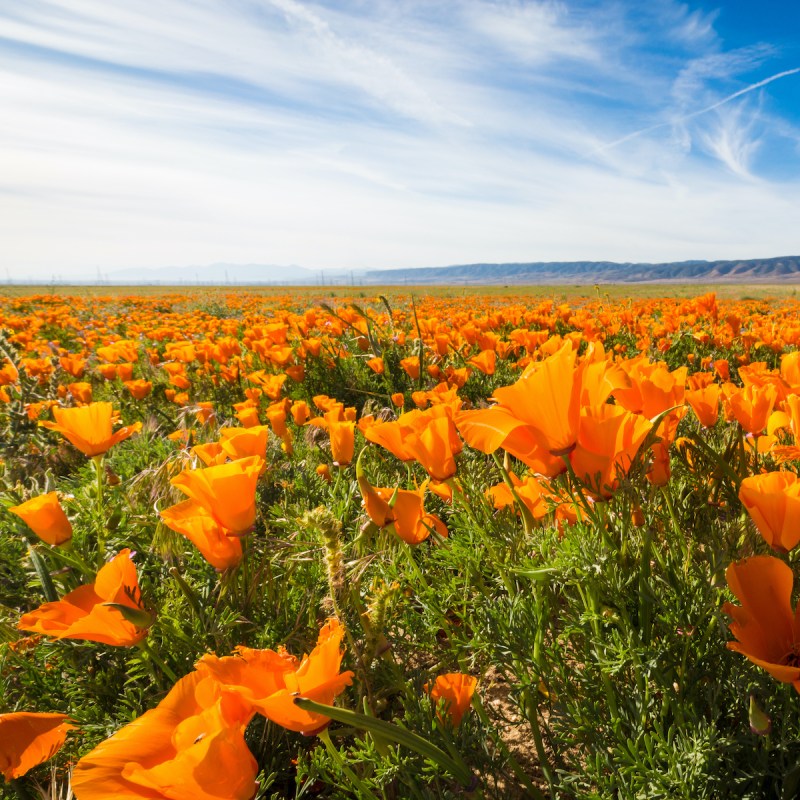
Lancaster, located in the high desert of California, is internationally known for the massive wildflower blooms that appear there each year in early spring. During this time, vibrant oranges, purples, yellows, blues, whites, and greens burst forth from the normally dry hills. The 29th-annual California Poppy Festival coincides with this wildflower bloom and celebrates California’s state flower.
Videos by TravelAwaits
On March 2, 1903, the California State Legislature deemed the California poppy, Eschscholzia californica, the official state flower of California, and designated April 6 as California Poppy Day. Let’s explore the California Poppy Festival, and learn where breathtaking displays of the California poppy can be found.

California Poppy Festival
The 2022 edition of the California Poppy Festival is scheduled to take place April 22 through April 24. Among the changes this year is a move to new digs at the Antelope Valley Fair and Event Center. The new, larger location can accommodate more festival-goers and offers easier parking.
“The event this year will be bigger and better than ever before,” says Lancaster Mayor R. Rex Parris. “As you know, we’ve canceled this event for the last two years due to the COVID-19 pandemic. So, we have some time we need to make up for!”
“I am so glad to see the partnership between the City of Lancaster and the AV Fair and Event Center for the 2022 California Poppy Festival,” adds Vice Mayor Marvin E. Crist. “This is a landmark event for not only Lancaster, but for the entire state of California.”
This year, the family-friendly event will feature more than 200 vendors, live entertainment, a beer garden, live animals, and more. Keep an eye out for the many ways poppies are presented at the festival. And what would a festival be without food? Expect to see your favorite fair fare on display and ready to be enjoyed.
The festival has an emphasis on local vendors and cultural groups. Though internationally-known musicians such as Poncho Sanchez and Spyro Gyra have graced the Poppy Festival stage, the trend has been toward entertainment from around the Antelope Valley. Marc Macisso and Mel Booker are just two examples.
And with a new venue comes new events. Since the venue is a fairground, on tap are events like the Rural Olympics, a monster truck show, plus a Hispanic rodeo and concert.
“The California Poppy Festival hosts 25,000 to 35,000 visitors each year and continues to grow in popularity”, says Jennifer Seguin, Manager of Communications at the City of Lancaster.

Getting There
The best way to get to the California Poppy Festival is to drive. However, if you would like to use public transportation, the City of Lancaster says Metrolink, Southern California’s commuter rail system, will be offering a regular schedule from a variety of locations in Los Angeles County to the Lancaster station, and AVTA, Antelope Valley’s bus system, will take anyone from the station right to the event at the AV Fair & Event Center. See the festival website for parking and admission information.

Antelope Valley California Poppy Reserve
About 15 miles west of the Antelope Valley Fair and Event Center lies the world-famous Antelope Valley California Poppy Reserve, where visitors can view colorful carpets of bright orange poppies dominating the hillsides along with patches of fiddlenecks, goldfields, lupine, cream cups, and other wildflowers.
Social media has skyrocketed the popularity of the poppy fields, leading to global recognition. It is one of the best places in Southern California to see wildflowers.
The Chumash, the indigenous people who inhabited California’s central and southern coasts, have a legend about poppies. The legend goes that in the time when animals were people, Lizard said to Coyote when describing a poppy flower, “When you see it, it is as if the sun itself is on the ground.” When you observe the poppy fields in person, especially during one of the larger blooms, you can easily see how this tale came to be.
Note that due to less-than-average rainfall this season, there is no superbloom in the forecast. However, there should still be a nice display of wildflowers, according to the February 27 update on the Poppy Reserve’s webpage.
Visit California suggests the best time of day to visit the reserve to see the poppies in bloom is mid-morning. By then, the daily temperature will have risen enough for the poppies to open, and the afternoon winds the valley is also famous for have not started up yet.
Pro Tip: I recommend arriving between the hours of 8:30 a.m. and 10 a.m. if you want to take good photographs.
There are approximately 8 miles of walkable trails on the reserve. A visit to the Jane S. Pinheiro Interpretive Center at the reserve either before or after your walk among the poppies will round out your experience. The center offers exhibits, artwork, dioramas, and a gift shop.

Hours And Parking
The Antelope Valley California Poppy Reserve is open all year between sunrise and sunset, though the Interpretive Center is only open while the wildflowers are in bloom during the spring. See parking details on the website.

California State Flower Pro Tips
Pro Tip #1: Though the poppies typically bloom in March or April, they can begin to open as early as mid-February and can last until late May. Numerous factors can affect the timing, size, and life cycle of the bloom. Weather, of course, is the main element, and it can be unpredictable. If you are planning to make a trip out to the reserve, trust me, get the latest intel on the blooms and conditions at the Poppy Reserve itself first.
Visit the Antelope Valley California Poppy Reserve website, the Poppy Reserve Facebook Page, or take a peek at the reserve’s PoppyCam.
Pro Tip #2: Observe the park’s rules. They are listed on the side and near the bottom of the reserve’s website. These include staying on marked trails, not picking the wildflowers, not bringing drones or dogs, and keeping an eye out for rattlesnakes. Authorities are serious about these rules. Again, trust me.
Pro Tip #3: If you do plan to visit the Poppy Reserve, be prepared to do a fair amount of walking. The trails cover rolling hills and range in elevation from 2,600 to 3,000 feet. The paved sections are wheelchair accessible. Bring comfortable walking shoes and a hat, and stay hydrated.
Pro Tip #4: Bring a camera!
